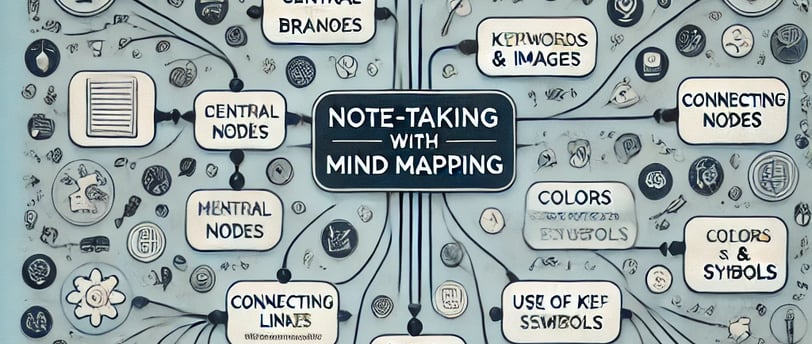The Ultimate Guide to Note-Taking with Mind Mapping: How to Create Effective Mind Maps for Better Organization and Productivity Introduction
Looking to supercharge your note-taking skills? Mind mapping is a game-changer for organizing thoughts, improving memory, and boosting productivity. In this comprehensive guide, we’ll walk you through the step-by-step process of creating mind maps, from defining a central idea to connecting nodes effectively. Learn how much text to use, when to incorporate colors and symbols, and how to integrate mind maps into your note-taking workflow. Whether you're a student, professional, or creative thinker, this guide will help you streamline your notes for maximum efficiency. Plus, we’ll share top book recommendations to deepen your understanding of mind mapping and note-taking.
NOTE TAKING
2/16/20253 min read


Mind mapping is a powerful visual tool that helps organize thoughts, improve creativity, and enhance memory. Whether you're a student, professional, or creative thinker, learning how to create an effective mind map can transform the way you take notes and process information. In this guide, we will explore the fundamentals of mind mapping, how to connect nodes effectively, the ideal amount of text to use, and how mind maps integrate with note-taking for maximum efficiency.
By the end of this article, you'll have a clear understanding of how to create a structured and meaningful mind map that boosts productivity and learning.
What is a Mind Map?
A mind map is a diagram that visually represents information, often centered around a main idea, with branches extending to related topics. This non-linear structure allows for easy association and recall, making it a valuable tool for brainstorming, planning, and note-taking.
Key Characteristics of a Mind Map:
Central Idea: The main topic or theme is placed at the center.
Branches: Connected subtopics radiate outward.
Keywords & Images: Minimal text with visuals to reinforce ideas.
Colors & Symbols: Used to enhance understanding and organization.
How to Create a Mind Map for Note-Taking
Step 1: Define the Central Idea
Start with a blank page or digital tool and place your main idea in the center. This could be a subject of study, a meeting topic, or a project goal.
Step 2: Add Main Branches
Draw lines extending from the central idea to represent major categories or key points related to your topic. These should be broad concepts that will later break down into smaller nodes.
Step 3: Connect Subtopics
From each main branch, create smaller branches for related subtopics. This hierarchical structure helps in breaking down complex ideas into manageable parts, making note-taking more effective.
Step 4: Use Keywords & Images
Keep text minimal—use single words or short phrases. Incorporate icons, sketches, or images to enhance recall and engagement.
Step 5: Incorporate Colors and Symbols
Using different colors for branches can help categorize information. Symbols like arrows, stars, and checkmarks can emphasize relationships and priorities, improving the clarity of your notes.
How to Connect Nodes Effectively for Better Note-Taking
The Importance of Relationships
Nodes should be connected logically to reflect the flow of ideas. Use:
Hierarchical Links: Show dependencies between ideas.
Cross-Links: Connect related ideas across different branches.
Arrows & Annotations: Indicate cause-effect relationships.
How Much Text Should You Use in a Mind Map for Note-Taking?
Use keywords rather than long sentences.
Keep descriptions short and to the point.
Avoid cluttering—too much text reduces visual clarity.
Use icons and symbols to replace words when possible.
Mind Mapping for Note-Taking: Maximizing Efficiency
Mind maps are excellent tools for organizing notes, summarizing information, and structuring ideas efficiently.
Benefits of Using Mind Maps for Note-Taking:
Enhances Recall: Visual elements improve memory retention.
Encourages Creativity: The non-linear format fosters creative thinking.
Saves Time: Helps in quickly summarizing and reviewing information.
How to Use Mind Maps for Note-Taking
Lecture Notes: Convert traditional notes into structured maps.
Book Summaries: Capture key points from books in a single glance.
Meeting Notes: Organize discussions into clear categories.
Book Recommendations for Mind Mapping and Note-Taking
"The Mind Map Book" by Tony Buzan – A foundational book on mind mapping techniques.
"How to Mind Map" by Tony Buzan – A step-by-step guide for beginners.
"Mind Mapping for Dummies" by Florian Rustler – A practical approach to mastering mind maps.
"Mapping Inner Space" by Nancy Margulies and Nusa Maal – A great book for educators and visual thinkers.
Conclusion
Mind mapping is a versatile and effective technique for note-taking, organizing thoughts, enhancing memory, and improving productivity. Whether you're using it for studying, planning, or personal organization, mastering mind maps can significantly boost your cognitive skills. By following the steps outlined in this guide, you can create structured, engaging, and meaningful mind maps that align with your goals.
Start implementing mind mapping in your note-taking routine today and experience the benefits firsthand!
